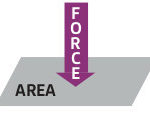
Dr. Orgill is Vice Chairman for Quality Improvement in the Department of Surgery at Brigham and Women’s Hospital and Professor of Surgery at Harvard Medical School. He is a reconstructive plastic surgeon and has a PhD from MIT in Medical Engineering. He is the Director of the Brigham and Women’s Hospital Wound Care Center and runs a tissue engineering and wound healing Laboratory. His lab at BWH is working to develop better technologies to treat wounds including work with artificial skin, micromechanical forces, platelets and stem cells. He has consulted for several medical device and start-up companies and is the inventor on several patents. He worked on the team that developed Integra®, a skin replacement therapy that has been commercially developed and used successfully on thousands of patients.
Orgill_Current Dialogues in Wound Management_2015_Volume 1_Issue 3
Pressure is an important concept of life on earth and has a direct relevance to wound healing. Pressure is measured in fluids (liquids and gases) and is defined as the force applied divided by the area to which it is applied (Figure 1). On earth at sea level, we are subjected to atmospheric pressure, about 15 lbs per square inch on our bodies or 760 mm Hg (Figure 2). For gases, we know that molecules have natural movement that increases with temperature. As temperature increases, the movement of individual molecules increases in velocity. It is the momentum of these molecules bouncing off a surface that creates effective pressure. Pressure is also dependent on volume. For example, in an internal combustion engine, a piston compresses the air within a cylinder causing increases in pressure within the cylinder. Mathematically for an ideal gas, the relationships between pressure, volume, and temperature are defined as:
PV = n R T
Where:
P = pressure
V= volume
n = number of moles of gas
R = Universal gas constant
T = temperature in degrees Kelvin
From this equation, it is easy to see that volume and temperature are always positive numbers. Therefore, pressure is always going to be a positive number. Many times, pressure is measured as the difference between the pressure of interest and a reference pressure (gauge pressure). That is why you will sometimes see pressures reported as negative. Very often it is in reference to atmospheric pressure. This can occur with a vacuum or suction.
For static fluids, the weight of the fluid column above a particular location within the fluid itself is the primary determinant of pressure at that spot. In water systems, scuba divers and submarines are subjected to very high pressures. In fact, mercury is used to calibrate pressure, as the height of a column of mercury provides a very reproducible measure of pressure. Mercury is often used because of its high density. If water, which is 1/13.6 the density of mercury, were used, the fluid columns to measure atmospheric pressure would be 13.6 times as high – making water less manageable for purposes of measurement.
For systems with fluid flow, complex mathematical relationships relate pressure to flow. In the cardiovascular system, the heart muscle squeezes blood out of the heart about 60 times per minute into the vascular system. Because of the resistance in the circulation and the presence of one-way valves, a complex pressure wave form is seen when pressure transducers are placed within the vascular system.
SPECIFIC CASES IN WHICH PRESSURE IS RELEVANT TO WOUND HEALING
Pressure ulcers
Direct pressure on soft tissues can stop local blood flow. For extremities, placing a tourniquet set to a pressure above arterial blood flow will stop blood flow to the extremity. Over bony prominences, it is easy to have pressures that exceed the perfusion pressure of the tissues resulting in lack of blood flow. Normally, with an intact nervous system, our body tells us that there is not enough perfusion (it hurts), and we spontaneously reposition ourselves to allow perfusion to these areas. Even when they are asleep, people often reposition themselves. We do know that after 2 to 4 hours of total lack of blood flow, tissues can start to die. This helps us understand the importance of pressure-relieving surfaces and positioning changes in preventing the occurrence of pressure sores.
Venous stasis disease
The venous system is remarkable in allowing blood to return to the heart even when we are standing up. It does this through muscular contractions and one-way valves in the venous system. If these valves get destroyed, and if abnormal connections between the deep and superficial veins exist, high pressures can develop in the venous system that can actually result in extravasation of blood into the soft tissues, causing color changes. To treat this problem, a variety of compression stockings and wraps have been devised.
Diabetic foot ulceration
Diabetic foot ulceration has a complex pathophysiology, but is often related to a combination of repetitive pressure on a bony prominence in a patient who has abnormal sensation. Working to relieve the biomechanical insult, as well as pressure-relieving footwear, are important principles in managing these patients.
Negative pressure wound therapy
We prefer the terms “subatmospheric pressure wound therapy” or “microdeformational wound therapy” to describe these types of devices. In essence, suction is applied to a wound through an interface material that is covered with a nearly nonpermeable covering. This facilitates the removal of fluids and also pulls the wound edges together. Suction is applied to create a pressure typically 125 mm Hg below ambient pressure (or the atmospheric pressure outside the covering). Clearly, it is not the absolute pressure that causes wound healing. Lower absolute pressure is felt in high-altitude locations, such as Denver, or in the cabin of a pressurized commercial jet. Wound healing in either of these environments is not faster than wound healing at sea level. Therefore, it must be the pressure differential that leads to the changes in wound healing. At a microscopic level, the interaction between the wound surface and the interface material causes microdeformations in the wound surface that help promote cell proliferation.
CONCLUSION
In summary, pressure is an important part of life and a very important concept to understand in wound healing. It is important in both the prevention and treatment of commonly seen wounds in our clinics.



